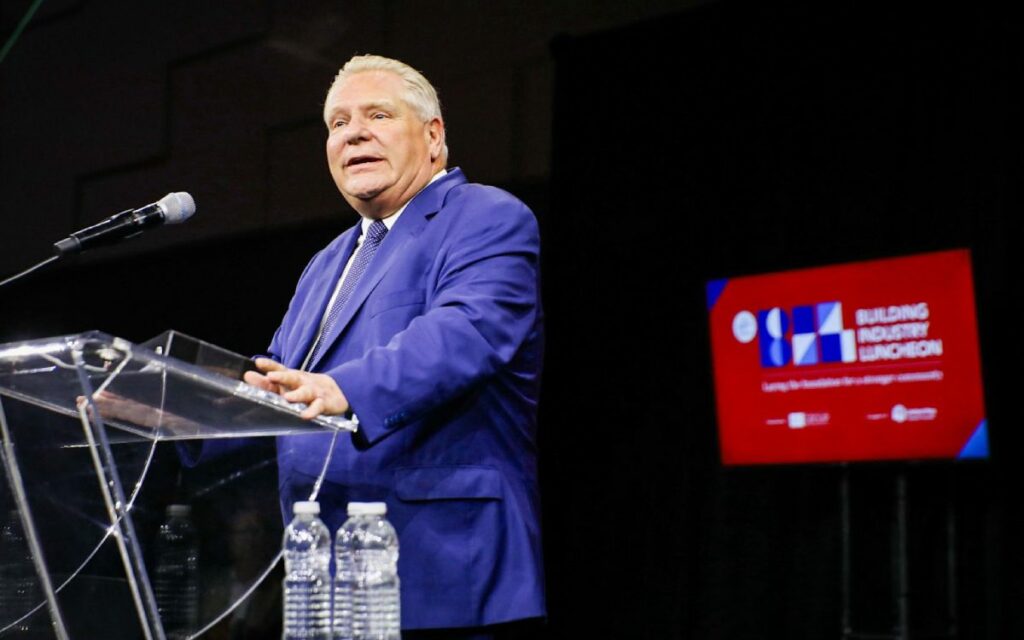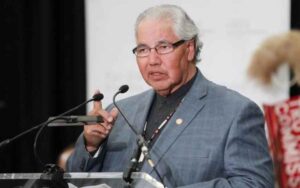
The province intends to virtually double the potential energy from wind from its current level, adding 5,000 megawatts of power, largely from additional wind turbines. Pictured: Premier Doug Ford. Photo Credit: Doug Ford/X.
Since their election in 2018, the Ford government has switched up its policy on energy several times. Prior to being elected, Ford and his colleagues expressed justified disdain for the disastrous Liberal Green Energy Act, which doubled electricity costs in Ontario, created energy poverty and damaged the province’s economic competitiveness. Ford promised to reduce electricity costs if elected and undo many of the very expensive contracts the Liberals had signed with so-called green energy producers. Early in the government’s tenure, Ford did cancel a range of these contacts at considerable cost to taxpayers, but claimed the savings from not producing unnecessary and costly green energy would more than offset the costs.
Electricity costs did not, however, come down. Instead, the Ford government took a page out of former premier Kathleen Wynne’s book and continued her policy of using tax dollars to subsidize electricity rates. This bait-and-switch approach technically keeps hydro bills to ratepayers from rising further but dumps the bill at the feet of all taxpayers. The subsidy has now reached over $6 billion annually and will continue to grow in future. This is not a solution.
As wind and solar power continue to be expensive and unreliable, the Ford government has wisely continued to expand nuclear facilities (which have a very long lead time to come into operation) and earlier this year changed its mind on decommissioning the Pickering nuclear facility. They chose to refurbish the plant instead, which will be completed by the mid-2030s. The Progressive Conservatives also have announced the construction of new natural gas plants to ensure the province can meet increasing energy demand. It appeared as if the government was by and large following a sensible, multi-pronged energy strategy that did not depend too heavily on any one energy source as all have their strengths and weaknesses. In any case, the current Ontario electricity grid is 94 per cent emissions-free and is one of the cleanest and most reliable in the world.
Another positive move was the overturning of an Ontario Energy Board (OEB) decision late last year to discourage the expansion of Enbridge’s natural gas grid to new housing developments. The OEB stated that the supposed transition away from fossil fuels toward so-called renewable energy options had to be factored into the decision. Then-energy minister Todd Smith disagreed, and said the government planned to overturn the OEB’s decision as natural gas will continue to be a reliable, affordable and low-emissions source of energy in the province and is needed to provide back up for unreliable wind and solar. That was a sensible decision on Smith’s part.
Given this seemingly balanced approach to ensuring the reliability and sufficiency of Ontario’s electricity grid into the future, with reliance on a variety of power sources, it seemed the province’s energy plan was in place. Then this – the announcement by the Ford government this week that it will be undertaking the largest expansion of so-called green energy since the Liberals were in power. Apparently, the province intends to virtually double the potential energy from wind from its current level, adding 5,000 megawatts of power, largely from additional wind turbines. The province claims that this abrupt change is necessitated by increased electricity demand and that the cost of wind and solar energy is declining.
Where did this sudden shift come from? Had the relentless lobbying by “green” organizations, typically funded by our tax dollars, finally penetrated the Ford government’s green energy scepticism? Did some internal Progressive Conservative party polling indicate that the Ford government would not be re-elected if they didn’t get more green? Who knows? As for the belief that the cost of wind and solar are falling, nothing could be further from the truth. The reality is that as a result of the notorious unreliability of wind and solar – demonstrated in spades in Alberta this past winter when people were asked to cut back on their electricity usage in temperatures of 40 below Celsius because wind power could not be relied on to provide power in an emergency situation – any system that can be counted on has to involve natural gas back-up. Yet the cost of the natural gas back-up is never included in wind and solar price estimates, but it should be.
Although the Ford government’s new pro-wind energy policy is yet to be fleshed out, one positive aspect is that municipalities will have the choice of refusing to install more wind turbines. Under the previous Liberal government, many municipalities did not want to install these eyesores that kill birds and other wildlife but were overruled by the McGuinty/Wynne Liberals. Hopefully, many municipalities will not buy in to having more wind turbines installed in their territory, although companies wanting to install the turbines frequently make monetary offers to the municipal governments that are difficult to refuse.
There is also the matter of the abrupt departure of Smith as a member of Ford’s government and Cabinet. Smith was energy minister from June 2022 until recently, when he was shuffled into the Education portfolio. Smith was the Minister in charge when the OEB decision to limit the use of natural gas in new housing developments was opposed late in 2023. Then last week, Smith suddenly resigned to pursue opportunities in the private sector. There is much gossip around this resignation, with some people claiming that Smith’s goals in the energy portfolio did not align with the Ford government’s, prompting first his shift to education minister and ultimately his resignation from the government. It’s difficult to know exactly why all of these events took place, but they surely are a number of significant changes within a short period of time.
For decades, electricity policy in Ontario was determined by engineers and other professionals who had no partisan interests, but merely strove to provide reliable, affordable power to Ontario families and businesses with infrastructure and planning based on science and expertise. Ontario’s stable and affordable electricity grid was a source of significant competitive advantage to the province for many years, attracting businesses and residents. Once politics started entering the picture in the form of “green” energy under the McGuinty Liberals, all of this went sideways and sensible, fact-based planning became subject to political energy fantasies that significantly increased the cost of electricity, reduced system reliability and damaged the province’s economy.
Perhaps the reason for the sudden and significant policy switcheroo on the part of the Ford government will become clearer in the days ahead. But for now, the answer is blowing in the wind.

She has published numerous articles in journals, magazines & other media on issues such as free trade, finance, entrepreneurship & women business owners. Ms. Swift is a past President of the Empire Club of Canada, a former Director of the CD Howe Institute, the Canadian Youth Business Foundation, SOS Children’s Villages, past President of the International Small Business Congress and current Director of the Fraser Institute. She was cited in 2003 & 2012 as one of the most powerful women in Canada by the Women’s Executive Network & is a recipient of the Queen’s Silver & Gold Jubilee medals.




















